Remove the air duct(A).

Make sure jacks and safety stands are placed properly.
Make sure the vehicle will not roll off stands and fall while you are working under it.
Use fender covers to avoid damaging painted surface.
Unplug the wiring connectors carefully while holding the connector portion to avoid damage.
Mark all wiring and hoses to avoid misconnection.
Also, be sure that they do not contact other wiring or hoses or interfere with other parts.
Secure the hood as open as possible.
Remove the air duct(A).

Disconnect the battery negative terminal first, then the positive terminal. Remove the battery.
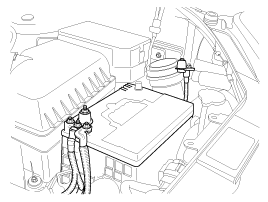
Remove the under cover(A).
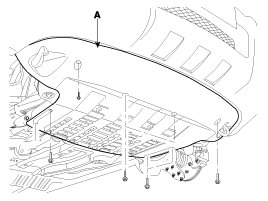
Drain the engine coolant after removing drain plug(A).
Remove the radiator cap to speed draining.
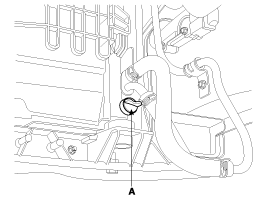
Remove the intake air duct and air cleaner housing.
Disconnect the air-flow sensor connector(A).
Remove the air cleaner assembly(B).

Remove the battery tray(A).
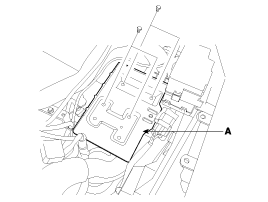
Remove the battery tray bracket(A).
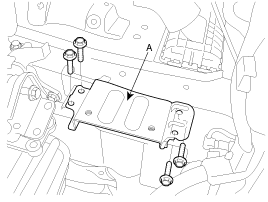
Remove the intercooler pipe(A).
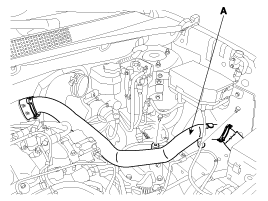
Remove the intercooler hoses(A).

Disconnect the engine wire harness connectors.
Disconnect the rail pressure sensor connector(A) and the water temperature sensor connector(B).
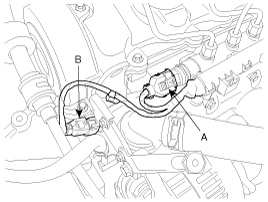
Disconnect the TDC(Top Dead Center Sensor) connector(A), rail pressure regulator connector(B), map sensor connector(C), swirl valve actuator connector(D) and wire harness protector(E).
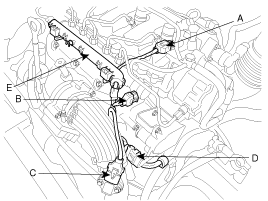
Disconnect the throttle body actuator connector(A).
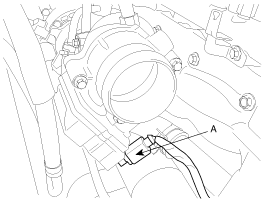
Disconnect the EGR (Emission gas recirculation) solenoid connector (A), glow plug connector(B) and fuel pressure regulator connector(C).
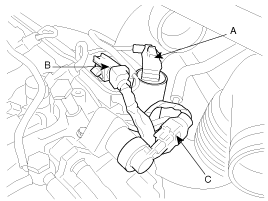
Disconnect the injector connector(A), lambda sensor connector(B), VGT exhaust gas temperature sensor connector(C) and wire harness protector(D) .
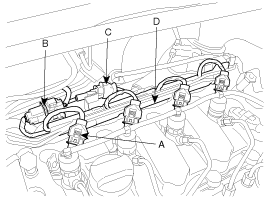
Disconnect the solenoid valve vacuum hose(A).
Disconnect the ground cable(B) from cylinder head.

Disconnect the fuel hoses(A) and fuel temperature sensor connector(B).

Disconnect the brake booster vacuum hose(A) and heater hose(B).
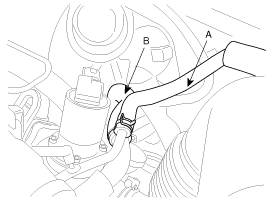
Disconnect the heater hose(A) from EGR cooler.

Disconnect the upper(A) and lower(B) radiator hoses.
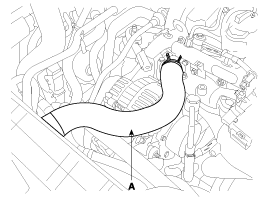
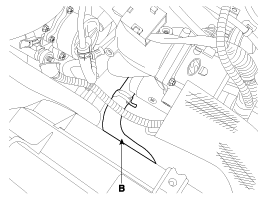
Disconnect the hose(A) from the engine coolant reservoir tank to the thermostat.
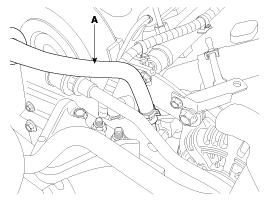
Disconnect the hose(A) from the engine coolant reservoir tank to the EGR cooler.
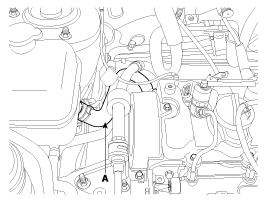
Disconnect the (+, - ) terminals(A) from fuse & relay box.

Disconnect the battery (-) terminal after removing the ground bolts(A).
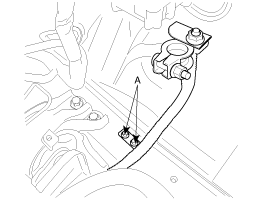
Disconnect the front lamp connector(A).
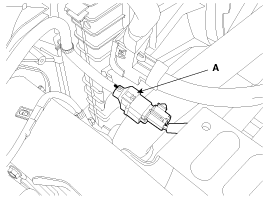
Disconnect the transaxle wire harness connectors and control cable (M/T).
Disconnect the oil pressure sensor connector(A), CKP(Crankshaft position sensor) connector(B) and neutral switch connector(C).
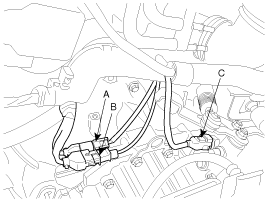
Disconnect the shift cable assembly(A) after removing the clips(B) and pins(C).
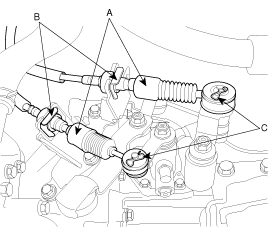
Disconnect the vehicle speed sensor connector.
Disconnect the back up lamp switch connector(A).

After removing the clip(B) with clamping(A) the concentric slave cylinder tube, disconnect the tube(C).
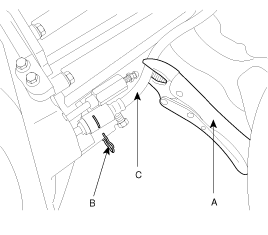
Drain the power steering oil.
Disconnect the power steering oil hose(A).
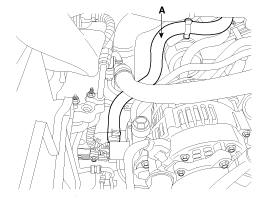
Disconnect the power steering return hose(A).
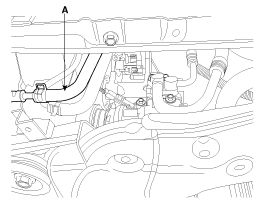
Recovering refrigerant and remove the high & low pressure pipe. (See HA group - air conditioner compressor)
Remove the steering column noise cover(A).
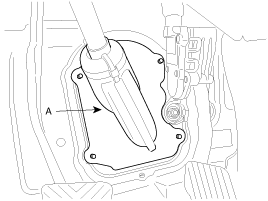
Remove the steering u-joint mounting bolt(A).
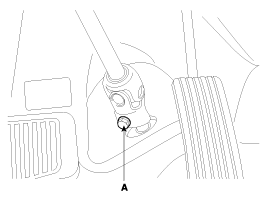
Remove the front tires.
Disconnect the wheel speed sensors(A) from both front knuckles. (See DS group - front axle)
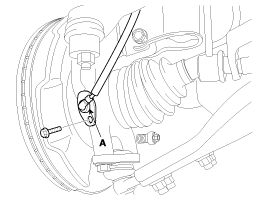
Remove the caliper and hang the caliper assembly(A).
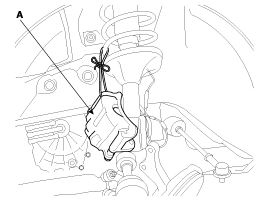
Remove the front strut lower mounting bolts and nuts. (See SS group - front strut)
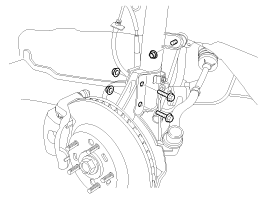
Remove the front muffler(A).
Tightening torque :
40 ~ 60N.m (400 ~ 600kgf.cm, 30 ~ 43lb-ft)
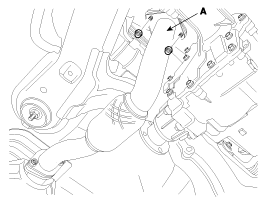
Remove the propeller shaft. (See DS group - propeller shaft)
Install the jack for supporting engine and transaxle assembly.
Remove the engine mounting bracket(A).
Tightening torque :
Nut (B) : 60 ~ 80N.m (600 ~ 800kgf.cm, 43 ~ 59lb-ft)
Bolts(C),Nut(D): 50~65N.m(500~650kgf.cm, 36~47lb-ft)
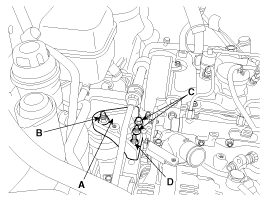
Remove the transaxle mounting bracket(A).
Tightening torque :
Bolt(B) : 90 ~ 110N.m (900 ~ 1100kgf.cm, 65 ~ 80lb-ft)
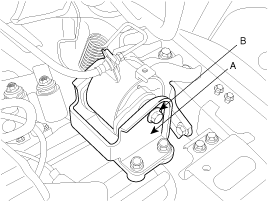
Remove the sub frame(A) mounting bolts and nut.
Tightening torque :
Bolt, nut(C)
70 ~ 90N.m (700 ~ 900kgf.cm, 51.6 ~ 66.4lb-ft)
Bolt(A, B)
160 ~ 180N.m (1600 ~ 1800kgf.cm, 118 ~ 132lb-ft)
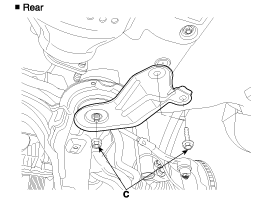
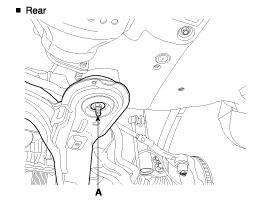
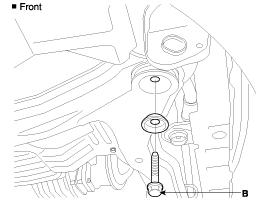
Remove the engine and transaxle assembly by lifting vehicle.
When remove the engine and transaxle assembly, be careful not to damage any surrounding parts or body components.
Install the engine in the reverse order of removal.
Reinstall the mount bolts/nuts in the following sequence.
Failure to follow these procedures may cause excessive noise and vibration, and reduce bushing life.
Install the sub frame installation bolt.
Tighten the engine and transmission mounting bolts.
Connect the power steering oil hoses.
Install the front muffler.
Install the front tires/wheels and splash shield.
Connect the air condition hoses.
Install the transmission links.
Connect the fuel hoses.
Connect the engine wire harness connectors.
Connect the radiator upper and lower hoses.
Connect the heater hoses.
Connect the hose to the reservoir tank.
Connect the intercooler hoses.
Install the air cleaner and the battery.
Perform the following :
Clean the areas where the driveshafts contact the transmission thoroughly with solvent or carburetor cleaner, and dry with compressed air.
Check that the snap rings on the ends of the driveshaft click into place.
Use new snap rings.
Adjust the shift cable.
Refill the radiator with engine coolant.
Bleed air from the cooling system with the heater valve open.
Clean the battery posts and cable terminals with sandpaper, assemble them, then apply grease to prevent corrosion.
Inspect for fuel leakage.
After assembly the fuel line, turn on the ignition switch (do not operate the starter) so that the fuel pump runs for approximately two seconds and the fuel line pressurizes. Repeat this operation two or three times, then check for fuel leakage at any point in the fuel line.